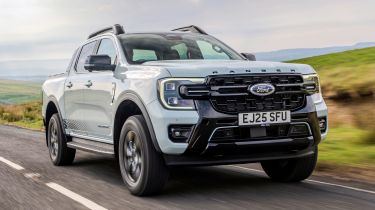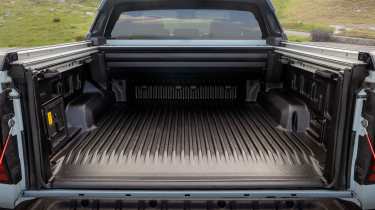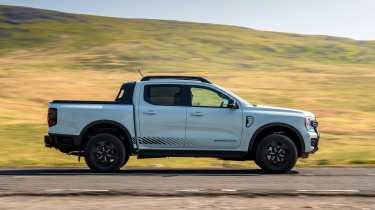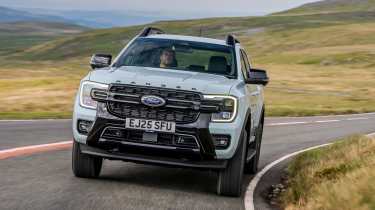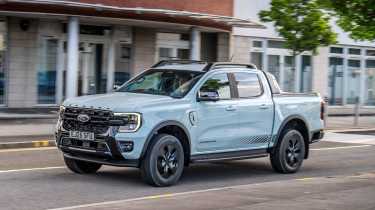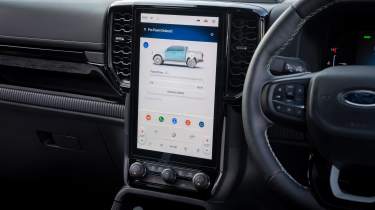Ford Ranger pick-up review
The Ford Ranger is as capable as it is upmarket, and you can even have it with a plug

Our opinion on the Ford Ranger
The latest Ford Ranger improves on its award-winning predecessor by injecting more style and technology into the mix. Its handsome, square-jawed looks and upmarket cabin gives SUVs a run for their money, while the variety of trim levels mean there’s a Ranger to suit all needs. The Double Cab version in particular is a great choice for business users who want a capable workhorse that can also serve as a versatile family car when they’re off the clock.
About the Ford Ranger
We’re big fans of the Ford Ranger at Auto Express, and it’s now won our Pick-up of the Year on more than five occasions. But seeing as the Ranger has also been the best-selling pick-up truck in the UK and Europe, we’re clearly not alone in our admiration of Ford’s workhorse.
The previous Ford Ranger had a trophy cabinet fit to burst, but after a little over a decade on sale, it was very much feeling its age by the time it was laid to rest. That’s when the latest Ranger strolled into town, with more of a resemblance to Ford’s iconic F-Series pick-up trucks this time around, and some big upgrades for the cabin.
The Ranger is longer and wider than before, while its bluff front end and square-jawed looks emulate the Ford F-150. Combined with the distinctive C-shaped daytime running lights and large Blue Oval in the middle of the wide grille, the Ranger has a rather imposing look – not something you’d normally say about a commercial vehicle.
Used - available now

2024 Toyota
Corolla
20,515 milesAutomaticPetrol2.0L
Cash £20,940
2019 Toyota
Aygo
15,940 milesManualPetrol1.0L
Cash £9,678
2024 Toyota
Aygo X
17,899 milesManualPetrol1.0L
Cash £12,814
2024 Toyota
Yaris Cross
15,151 milesAutomaticPetrol1.5L
Cash £24,383Another cue swiped from its all-American brethren is the Ranger name stamped into the tailgate, as opposed to the stickers seen on the old model. Ford also added a handy step to the bodywork behind the rear wheel (on higher-spec variants) after customer feedback found owners were using the rear tyre to step up to access the cargo area. The truck bed is larger, while the Ranger still satisfies the one-tonne payload requirement (apart from the high-performance Raptor version) that's needed for a pick-up to qualify as a light commercial vehicle. You can even use the tailgate as a workbench thanks to built-in holes for clamps.
The Ford Ranger is sold as a durable, dependable vehicle for the toughest of tasks, so naturally, we’ve been sure to put it to the test from day one. As well as testing multiple variants of the Ranger on UK roads, we’ve also pitted it against key rivals such as the Toyota Hilux and even the Land Rover Defender in a series of real-world group tests. The Ranger is a consistently high scorer due to factors such as its sensible pricing, versatility and surprisingly upmarket appeal. After all, there are very good reasons why it's a multiple Auto Express New Car Award winner.
MPG, CO2 and Running Costs
Pros |
|
Cons |
|
According to Ford, the 2.0-litre four-cylinder Bi-Turbo EcoBlue diesel (only available until the end of 2025) will return 33.6mpg on average in base Single Cab models fitted with a six-speed manual. Meanwhile, Double Cab models with a more powerful version of the same engine and 10-speed automatic are expected to return between 27.2mpg and 32.1mpg at best, depending on which trim you choose.
The 3.0-litre EcoBlue V6 soldiers on as the sole diesel choice in 2026, and claims a very traditional 28mpg. This engine should get close to this figure in the real world, because we managed to average 27.5mpg during our group test between the Ranger, Toyota Hilux, and Volkswagen Amarok.
Unsurprisingly, the fiery Ranger Raptor is the least efficient of the pack. Equipped with a mad 3.0-litre Ecoboost V6 and all its 288bhp, you’ll average around 20.5mpg at best.
Electric range, battery life and charge time
Electrification is the aim of the game in the automotive industry right now, and plenty of models are either going fully electric or being fitted with a hybrid system of some description. Until now, the Ranger has stuck with traditional diesel power for the most part, but the addition of a plug-in hybrid model in 2025 has seen Ford’s pick-up enter this new territory for the very first time.
The PHEV powertrain in question brings some environmental and tax benefits, but the headline figures are up to 26 miles of pure-electric range and 94.2mpg on the WLTP combined cycle. In real-world driving, we saw a more realistic 35mpg from the plug-in hybrid, and while that is less than advertised, it’s still better than what we’ve experienced from the rest of the Ranger range. The plug-in hybrid also offers near-identical carrying and towing capabilities to its petrol and diesel brethren.
To get an accurate valuation on a specific model check out our free car valuation tool...
Load Space and Practicality
Pros |
|
Cons |
|
The Ford Ranger isn’t a one-size-fits-all pick-up. The base Single Cab is a traditional two-seater pick-up that offers a maximum load length of 2,332mm and 1,207kg gross payload – the highest of the Ranger family.
Our favourite arrangement is the Double Cab version because its four-door layout is far more versatile, and its rear seats have been redesigned to be more comfortable for passengers, with ample space in the back for adults. Rear passengers also get a centre armrest with cup holders, air vents and USB sockets (one Type A and one Type C) to keep their devices charged. It’s no SUV, but the Ranger can pull double duty as a workhorse and family car when needed.
Most Double Cab Rangers satisfy the one-tonne payload requirement that's needed for a pick-up to qualify as a commercial vehicle, with the XLT model able to haul the most – 1,099kg to be exact. The only Ranger that doesn’t meet this threshold is the Raptor, with its maximum payload of 652kg. Both figures are somewhat short of the 1,040kg threshold required for LCV classification, and because the Raptor can’t be classed as a light commercial vehicle, it doesn’t qualify for the Benefit-In-Kind (BiK) tax advantage that draws many towards buying a pick-up.
We measured the bed of the Ranger Double Cab ourselves when we tested it and found the maximum load length to be 1,575mm. We also found the maximum load width is 1,515mm, but this narrows to 1,190mm towards the rear of the bed due to the wheel arches. The drop-down tailgate features an easy-close feature that makes it less of a workout to shut it than other pick-up trucks, and has holes for clamps so that it can be used as a workbench. If you run out of room in the bed, all regular Rangers are rated to tow a trailer up to 3,500kg, and this includes the plug-in hybrid. The Raptor, on the other hand, can only tow 2,500kg.
Ford offers a huge number of accessories for the Ranger. Take a gander through the options list, and you’ll find spray-in bed liners, a flexible rack system, dividers for the load bed, and hard-top canopies that essentially turn the Ranger Double Cab into a full-size SUV. Alternatively, to create secure storage, you can add a conventional soft tonneau cover, a manual roll-top cover and even a power-opening roll-top cover. You open the latter simply by tapping a button on the key or the inside of the load bed. However, we found that the cover’s plastic housing eats up quite a bit of space towards the rear of the load bed.
Reliability and safety
Pros |
|
Cons |
|
The Ford Ranger has always been near the top of the pick-up class in terms of safety, and the latest model is no different. It was put through Euro NCAP’s battery of crash tests in 2022 and was awarded the maximum five out of five-star safety rating. It received an 84 per cent score for adult occupant protection and safety assistance technology, 90 per cent for child occupant protection and 74 per cent for the vulnerable road user categories. Unsurprisingly, the similar VW Amarok received the same marks. The Ranger and Amarok did better in most areas against the only other pick-up that’s been tested under the same criteria, the Isuzu D-Max, with only the Crew-Cab version of the latter getting a superior 86 per cent in adult occupant protection.
All Rangers come with several airbags, seatbelt reminders, ABS, Ford’s ESP+ stability control system, collision mitigation, speed sign recognition, lane keeping aid and a rear-view camera. Additional safety kit, including a 360-degree camera set-up, lane change warning, blind spot monitoring and adaptive cruise control, are available as part of the several Technology Packs Ford offers.
We’re not hearing many horror stories about the Ranger’s reliability, but you're never far from a Ford dealer or Transit Centre for a service or if spares are required. All Rangers come with a three-year/60,000-mile warranty, which is pretty standard for the class. You get a year of Ford Assistance breakdown cover and a 12-year anti-perforation warranty thrown in. You can also add an extended warranty and service plans should you wish.
Driving and Performance
Pros |
|
Cons |
|
It may be a commercial vehicle at heart, but the latest Ranger is one of only a handful of pick-ups that can genuinely double up as an enjoyable everyday car. There’s no escaping its bulk, but useful tech and refined powertrains make it easier and more pleasant to drive than it looks.
Ford is phasing out the 2.0-litre diesel Ranger at the end of 2025, but the good news is that both the more powerful 3.0-litre diesel and 2.3-litre plug-in hybrid will remain. Every Ranger is four-wheel drive.
If you get your order in quick, the 2.0-litre four-cylinder delivers decent power when unladen. We did notice a fair amount of rev hang after lifting off the throttle and a noticeable delay in acceleration when you plant your right foot on the accelerator. We suspect the latter is caused by the 10-speed automatic gearbox having to kick down several gears when you demand more power. It can also be quite jerky at lower speeds, but once you’re out of town and driving at higher speeds, the 10-speed auto delivers smooth, seamless shifts.
The diesel is a six-cylinder engine producing 237bhp and 600Nm of torque, and these are good for a 0-62mph time of 9.7 seconds. The plug-in hybrid, meanwhile, consists of a 2.3-litre petrol engine working in tandem with an electric motor. This setup results in a slightly quicker 0-62mph time of 9.2 seconds, courtesy of a combined 277bhp and 697Nm of torque.
These figures mean there’s no power sacrifices to be made if you’d prefer your truck with a plug, and this is one of the reasons why Ford has axed the smaller 2.0-litre altogether.
Ford appears to be of the opinion that work can indeed be combined with pleasure, as there are two sporty Ranger models to choose from alongside the core line-up. First up is the Ford Ranger MS-RT, and this is the option for those who want racier looks but without sacrificing the regular truck’s capability. Inside sits the 3.0-litre V6 diesel once again, but it’s only slightly quicker with an 8.7 second 0-62mph time.
For the maddest of prospective truck owners, Ford also offers the Ranger Raptor. This is the full-fat performance model and it comes with a 288bhp 3.0-litre V6 petrol under the bonnet. This will launch the hefty pick-up from 0-62mph in 7.9 seconds, which is just starting to creep into hot hatch territory. The key difference, though, is that this rugged four-wheel drive machine is just as much fun off the road as it is on it.
Town driving, visibility and parking
Unsurprisingly, the Ranger feels very big to drive in town, but no more than a full-size SUV does. In fact, because of the Ranger's high-set driving position, you get a commanding view ahead that’s better than most SUVs, although the tall bonnet does limit the view immediately ahead.
XLT and Wildtrak models come with a reversing camera fitted, but the fancier Stormtrak and Platinum trims upgrade this to a 360-degree camera system. The latter provides a clear image of what’s around you via the high-res central touchscreen, helping to make it far easier to manoeuvre the Ranger into spaces. However, the sheer size of the truck means you will probably stick out of a typical supermarket parking space by a couple of feet. The good news is that the relatively light steering is especially helpful when negotiating your way around a tight car park.
Motorway driving and long-distance comfort
We found the Ranger is at its best when cruising on the motorway, where both the diesel and PHEV models settle down with road noise being kept in check for the most part. There is a noticeable amount of wind noise at higher speed, but that’s to be expected with such a bluff front end as the Ranger’s. An excellent adaptive cruise control system and lane keep assistance also help towards making the Ranger a solid cruiser.
The V6 diesel is a lot smoother than the soon-to-be-discontinued four-cylinder. It sounds silky at all speeds, and it delivers a decent amount of punch in everyday driving. However, we did find the truck to be a little hesitant to deliver maximum power when accelerating hard, as if it’s restricting power to prevent damage to the transmission. Response times do at least improve at higher speeds.
When it comes to their ride, pick-up trucks need to find a balance between comfort and the ability to cope with a one-tonne payload, and the Ranger manages to offer a smooth ride similar to that of an SUV. During our group test between the Ford Ranger, VW Amarok, and Toyota Hilux we found the Ford had the smoothest and most comfortable ride of the trio. That’s thanks to the combination of modest 18-inch wheels, high-profile tyres, and the Soft Ride comfort suspension fitted to the Ranger Wildtrak we tested. Without any cargo in the bed, you only tend to feel the biggest bumps and imperfections in the Ford, whereas its VW sister car tends to shudder and shake.
Cab and Interior
Pros |
|
Cons |
|
The Ford Ranger’s interior was already relatively upmarket (at least by pick-up truck standards), but the latest model has gone a good few steps further. In fact, we reckon it could give some well-regarded SUVs a run for their money.
The Ranger's cab has more space inside than the old model, and the addition of an electric parking brake also helps to free up space on the centre console. There’s plenty of storage space, including two cupholders in the centre console, plus two more that pop out from either end of the dashboard, twin glove boxes and a shelf in between, and another bin under the central armrest. There’s also a tray for your smartphone in the dash, which includes a wireless charging pad in pricier models.
The front seats are wide and comfortable and offer lots of adjustability, although the headrests are as hard as rocks. The Ranger’s interior door handles take a bit of getting used to because they’re inside the grab handles on the doors, and aren’t that easy to spot.
Key touchpoints feel very high quality, including the steering wheel, tops of the doors and centre console. However, poke around a bit and it doesn’t take long to find some hard, scratchy plastics. We have no doubt they’ll be durable and suit lower-spec versions destined to be workhorses, but they’re a bit of let down in the cabin of plusher models, which some will be considering as a family SUV alternative.
Infotainment, sat-nav and stereo
As soon as you climb in, your eyes are drawn to the enormous central touchscreen that dominates the dashboard. In lower-spec models, it’s a pretty substantial 10-inch unit, while others (like the Wildtrak we drove) feature a huge 12-inch portrait-style display. Both versions run Ford’s latest SYNC 4 infotainment, which is pretty slick and has quick load times, but the blue font on white backgrounds can be a little distracting.
Both Apple CarPlay and Android Auto are standard-fit. The smartphone projection only takes up about half the screen, which might disappoint some, but it means you have climate controls and handy shortcuts to the settings menu there all the time. It’s also good to see Ford hasn’t given up on good old-fashioned physical buttons, unlike its VW Amarok sibling, because there’s an array of them below the central touchscreen for the climate control and audio systems.
The crisp digital instrument panel provides ample information, from fuel economy to 4x4 status. The display also changes depending on the drive mode you select. However, we weren’t able to display a full map view even when using Ford’s own sat-nav; we could only provide turn-by-turn instructions. The digital driver instrument cluster in the Amarok can manage this and is generally more configurable.
There is a range of driving modes, which you switch through using the rotary dial on the centre console. On top of this are four buttons, which also allow you to select between two, and four-wheel drive modes.
Buying and owning
Due to the associated tax savings, eco credentials, lower running costs and lugging capabilities that are equal to its diesel counterpart, we’d opt for plug-in hybrid power. Combine this with Stormtrak trim, and you’ll enjoy plenty of upmarket touches and tech, which make this pick-up into a genuine candidate for everyday family car use.
Pick-up dimensions
| Body style | Height | Width | Length |
|---|---|---|---|
| Single Cab | 1,880mm | 1,918mm (2,208mm inc mirrors) | 5,370mm |
| Double Cab | 1,884mm | 1,918mm (2,208mm inc mirrors) | 5,370mm |
Load area dimensions
| Body style | Height | Width | Length |
|---|---|---|---|
| Single Cab | 529mm | 1,224-1,584mm | 2,332mm |
| Double Cab | 529mm | 1,224-1,584mm | 1,564mm |
Frequently Asked Questions
The Ford Ranger is more practical, more comfortable and better equipped than ever, with a wide range of models available to suit all needs. It’s a top-notch combination that’s won our Pick-up Truck of the Year award on several occasions.

